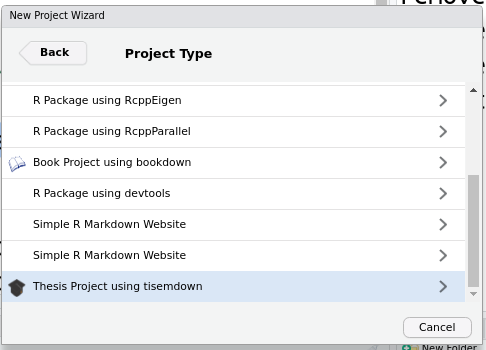This project provides a RMarkdown template to support Tilburg School of Economics and Management students to adhere to thesis formatting guidelines for their Masters Thesis.
{tisemdown} builds PDF files from R Markdown documents using LaTeX. You need to make sure that LaTeX and R Markdown are installed on your PC. To do this:
- Open RStudio
- Enter the following lines into the console and press
RETURN:
install.packages(c('tinytex', 'rmarkdown', 'bookdown'))
# below installs latex
tinytex::install_tinytex()
# after restarting RStudio, confirm that you have LaTeX with
tinytex:::is_tinytex()tisemdown is installed from GitHub:
if (!require("remotes"))
install.packages("remotes", repos = "https://cran.rstudio.org")
remotes::install_github("deer-marketing-lab/tisemdown")Note that you will need to restart RStudio at this point before going to the next step.
Follow these steps:
- Create a new RStudio project with a {tisemdown} template.
- In RStudio, click on File > New Project > New Directory.
- Then select Thesis Project using tisemdown from the
dropdown. It will be near the bottom.
- HINT: You’ll see the graduation cap as the icon on the left for the appropriate project type.
- Next, give your project a name and specify where you’d like the
files to appear. In the screenshot below, the project name is
my_thesisand it will appear as a new folder on my Desktop.
-
After choosing which type of output you’d like in the YAML at the top of
index.Rmd, Knit theindex.Rmdfile to get the book in PDF or HTML formats. The PDF file of your thesis will be deposited in the_book/directory, by default. -
To add new chapters, edit existing- or create new Rmd files with your thesis content
You need to edit the individual chapter R Markdown files to write your
thesis. It’s recommended that you version control your thesis using
GitHub if possible. RStudio can also easily sync up with GitHub to make
the process easier. While writing, you should git commit your work
frequently, after every major activity on your thesis. For example,
every few paragraphs or section of text, and after major step of
analysis development. You should git push at the end of each work
session before you leave your computer or change tasks. For a gentle,
novice-friendly guide to getting starting with using Git with R and
RStudio, see https://happygitwithr.com/.
To render your thesis into a PDF, open index.Rmd in RStudio and then
click the “knit” button. To change the output formats between PDF,
gitbook and Word, look at the output: field in index.Rmd and
comment-out the formats you don’t want.
The knitted file of your thesis will be deposited in the _book/
directory, by default.
The following components are ones you should edit to customize your thesis:
This file contains all the meta information that goes at the beginning
of your document. You’ll need to edit the top portion of this file (the
YAML) to put your name on the first page, the title of your thesis, etc.
Note that you need to have at least one chapter start in the index.Rmd
file for the build to work. For the template, this is done with
# Introduction in the example from the template.
These are the Rmd files for each chapter in your dissertation. Write your thesis in these. If you’re writing in RStudio, you may find the wordcount addin useful for getting word counts and readability statistics in R Markdown documents.
Store your bibliography (as bibtex files) here. We recommend using the citr addin and Zotero to efficiently manage and insert citations.
Specific style files for bibliographies should be stored here. A good source for citation styles is https://github.com/citation-style-language/styles#readme.
Store your figures and data here and reference them in your R Markdown files. See the bookdown book for details on cross-referencing items using R Markdown.
This is the main configuration file for your thesis. You can change the name of your outputted file here for your thesis and other options about your thesis here.
Generally, I wouldn’t change this file
Currently, the PDF and gitbook versions are fully-functional. The word and epub versions are developmental, have no templates behind them, and are essentially calls to the appropriate functions in bookdown.
Under the hood, the a LaTeX template is used to ensure that documents conform precisely to submission standards. At the same time, composition and formatting can be done using lightweight markdown syntax, and R code and its output can be seamlessly included using rmarkdown.
You may need to install a few extra LaTeX packages as your thesis develops. Here is one such example of how to do so:
tinytex::tlmgr_install("babel-portuges")This project was inspired by the thesisdown and bookdown packages.




